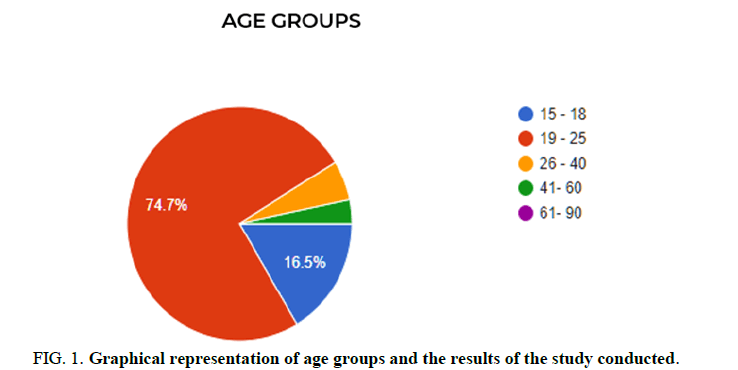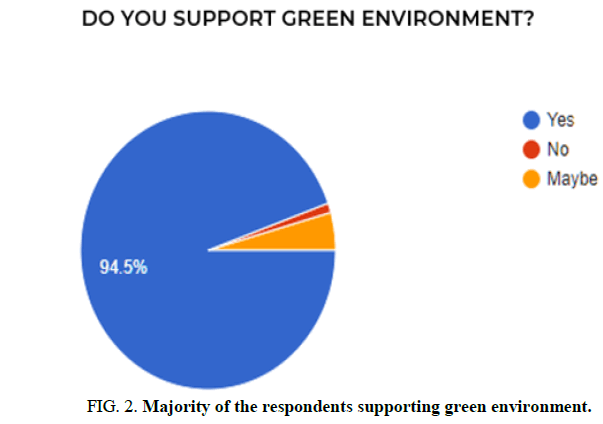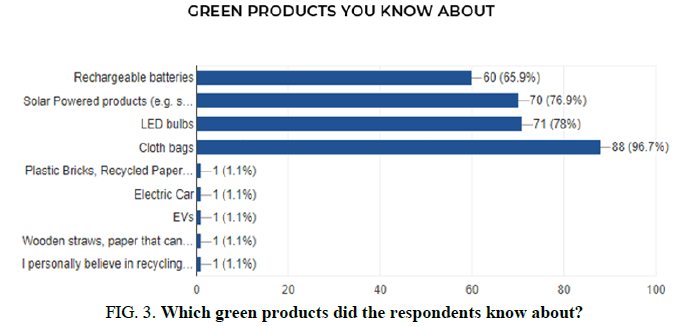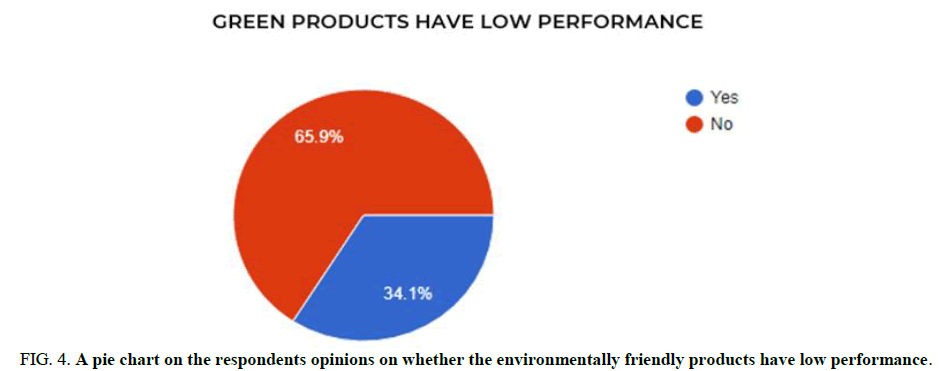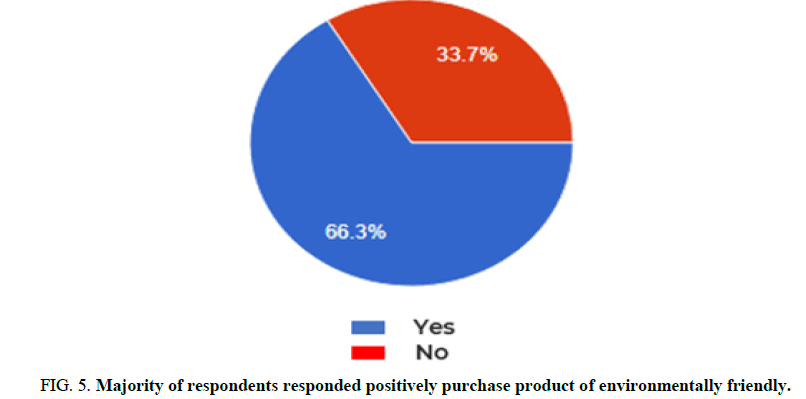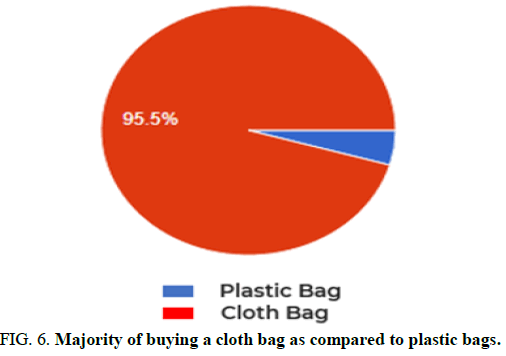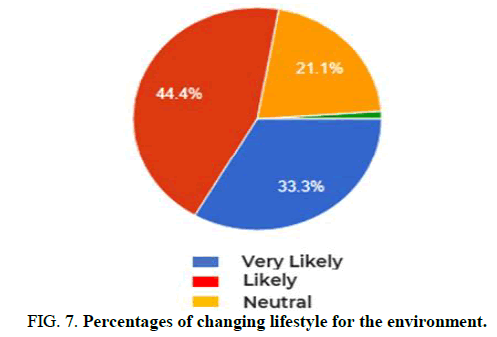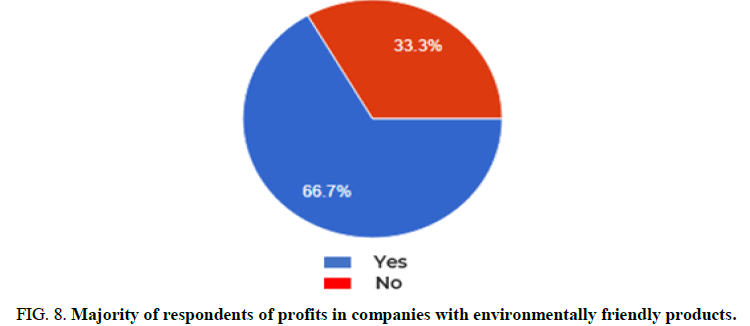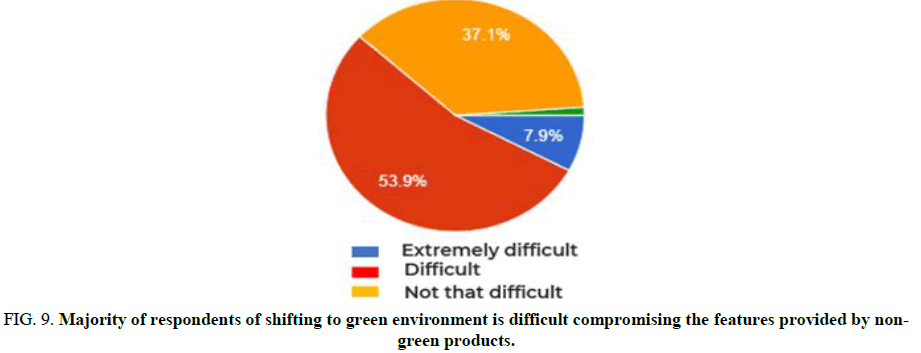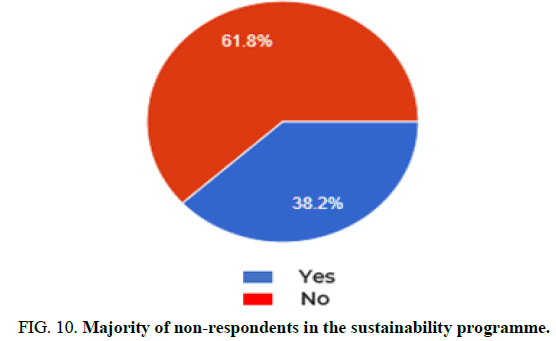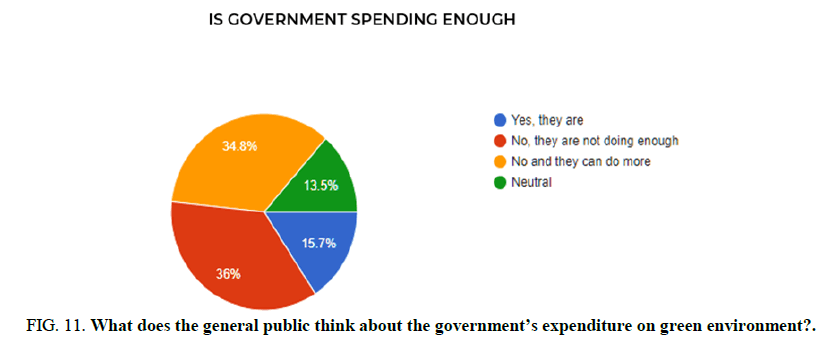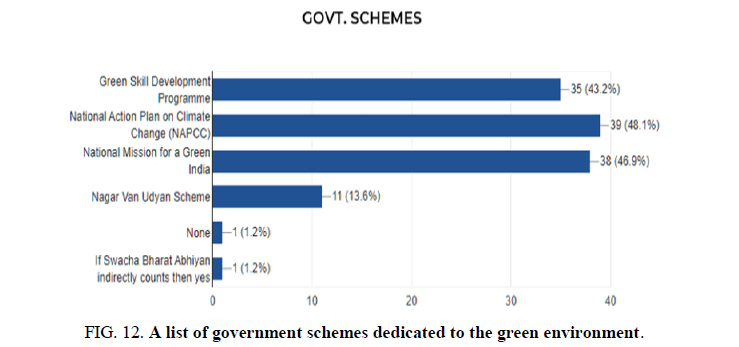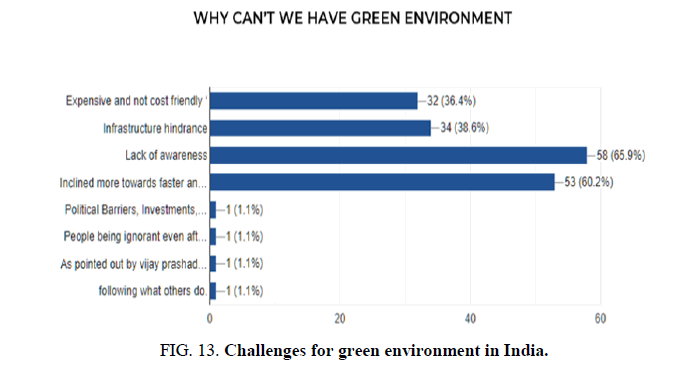Research
, Volume: 19( 1)To Study the Acceptance of Shift towards Green Environment
- *Correspondence:
- Preet M Paatel
Department of Environmental Science,
Nagindas Khandwala College,
Mumbai,
Maharashtra,
India,
Tel: 9920607009;
E-mail: preetmpaatel@gmail.com
Received: January 20, 2023, Manuscript No. TSES-23-87576; Editor assigned: January 23, 2023, PreQC No. TSES-23-87576 (PQ); Reviewed: February 06, 2023, QC No. TSES-23-87576; Revised: April 18, 2023, Manuscript No. TSES-23-87576 (R); Published: April 25, 2023, DOI: 10.37532/0974-7451.2023.19(1).265
Citation: Paatel PM, Alva A, Katkoria M. To Study the Acceptance of Shift towards Green Environment. Environ Sci Ind J. 2023;19(1):265.
Abstract
Green environment, being one of the most spoken topics in the last decade. Harmful materials like High Density Polyethylene (HDPE), Low Density Polyethylene (LDPE), Polypropylene (PP), etc. are released into the environment every day in bulk and the recycle programmes are not able to keep up with the ever increasing waste generated. These materials when mixed with marine life or buried in ground may result in negative impact for the animals and plants. Multiple studies have showcased the harmful reactions to not only the marine life or nature, but also to humans. This study aims to determine the acceptance of change from using the cheap materials to carry on day to day tasks so that the environment and humans can save themselves. In this context, green environment means recyclable objects which can be reused multiple times. The results of this study are that people are more likely to accept the change in their buying habits if it means having a greener environment.
Keywords
Recycle; Green; Environment; Shift; Habits
Introduction
In recent years, there has been a drastic change in the lifestyle of people; mixture of positive and negative. Industrial scale production began in the 1950’s and has been gathering pace ever since. Two years ago, the total amount of plastic produced till date was 8.3 billion tons [1]. Of that, 6.3 billion had turned into plastic waste. Only 9 percent of that waste was recycled and 12 percent was incinerated. A whopping 79 percent ended up in landfills or the environment [2]. The plastic now amounts to some 400 million tons per year, yet only an estimated 12% of the plastics produced have been incinerated and only an estimated 9% have been recycled. Manufacturers of renewable items are now focusing to create as many new environmentally friendly products as possible in the most efficient way [3-5]. Creating new products which are less harmful to the environment takes a lot of effort and resources which makes it an expensive choice as compared to its counterpart i.e., plastics. Plastic seems to be a reasonable choice when used repeatedly and not thrown away after one use. Single use plastics seem to be a major source of pollution since they serve no purpose after being used once. The SARS COVID-19 pandemic witnessed a surplus of single use mask and PPE kits being produced and discarded as medical waste. The acknowledgement of the fact that plastic is ruining the environment is EO IPSO a big milestone in a world with multiple ideologies about the same thing. Creating an efficient system of production should also be taken care of and not only the resultant product [6]. For example, the current scenario of electric vehicles in India is more polluting than helping. It creates more pollution to produce an electric vehicle than producing a petrol/diesel vehicle. The charging stations being powered by coal also contributes to a major source of pollution.
The objectives of the research are as follows:
•To understand the acceptance of shift towards green environment in world.
•To know the major hindrances towards the shift of green world.
•To know people’s perspective towards the shift and how likely are they to change their lifestyle for it.
•To decipher whether various steps taken by government/organizations for green environment are reaching to people or not.
•To understand the graveness of the problem in current situations.
Materials and Methods
This research paper is concluded based on a survey taken through a questionnaire. The questionnaire cumulated 102 responses.
Data from various magazines, news and books are referred.
Study area
The study will be conducted in India and specifically in the Mumbai metropolitan area consisting of Mumbai (Bombay) and its satellite towns in the northern Konkan division, of the Maharashtra state in western India. The region has an area of 6,355 square kilometres (2,454 sq. mi) and with a population of over 26 million it is among the most populous metropolitan areas in the world. Since Mumbai is one of the most populous cities in India, this region was selected as the best area to conduct our study in. This study was conducted for over one month.
Sampling size
The responses were collected from several areas in Mumbai and from other areas in India where the population with mixed income groups were present.
Sampling method
For this study, we used simple random sampling method. We shared a questionnaire in areas surrounding the Mumbai metropolitan area and we received 92 responses for the same. From the received responses, we prepared charts and pie diagrams to interpret the data further. We also used the below mentioned methods:
•Pre field method.
•Field method.
•Post field method.
Pre-field method: This includes the collection of secondary information on the approached from different sources. Numerous publications from the library were recommended in order to gain a thorough understanding of the subject field. Additionally, books, documents, journal papers, newspaper articles, websites, etc. were used. For secondary data, some recent internet articles from other publications were also consulted.
Field method: Both qualitative and quantitative data collection techniques are used when doing field observations. Data from the 15-40 age range was gathered using the questionnaire approach. 92 people made up the sample size. Simple random samplingtechniques were employed. Primary data were gathered using questionnaires, observations and group discussion techniques. Thisstudy uses a descriptive research design. The responders are from Mumbai.
Post-field method: The primary and secondary data will be processed, assimilated and analyzed using a variety of techniques. Data analysis was done using statistical methods. An appropriate bibliography is created to list the sources consulted. The research has a descriptive design. The data collected both primary and secondary, will be processed, assimilated and analysed with the help of multiple methods. Statistical tools were used for analyzing the data. A suitable bibliography is prepared to show the references used. The research design is descriptive in nature. This research paper is based on a survey taken through a questionnaire. There are 92 responses. Data from various magazines, news and books are referred.
Results
Age group: The questionnaire was filled by 74.4% people in the age group of 19-25 and 16.5% people in the age group of 15-18. Below is the graphical representation and the results of the study conducted (Figure 1).
Support for green environment: Majority of our respondents responded they support the movement of green environment. This shall include the fact that they are aware of the green environment programme (Figure 2).
Which green products did the respondents know about: Majority of the respondents (96.7%) knew about cloth bags which are famously available at the local stores and fashion outlets for a small price. Seconded by LED bulbs, 78% respondents were aware about them. The shift to the LED bulbs from CFL bulbs can be the reason behind it and the savings in electricity plays a major role in the popularity (Figure 3).
Are green products low in performance: 65.9% of the respondents have the opinion that green products do not have any difference in performance of product as compared to the non-green alternatives?. Taking an example mentioned in clause 6.3, LED bulbs are not only cheaper to consume but also high performance and lasts longer than the CFL counterpart. Whereas current electric vehicles are bound by less distance and speed but are also much cheaper than the petrol/diesel counterparts (Figure 4).
FIG 4: A pie chart on the respondents opinions on whether the environmentally friendly products have low performance.
Would you buy expensive products being green or not: Majority of respondents (66.3%) responded positively that they will purchase a product which is environmentally friendly if it meant that they were environment friendly (Figure 5).
Cloth bags versus plastic bags: A clear majority of 95.5% chose that they would prefer buying a cloth bag which is 8 rupees per unit and lasts longer as compared to plastic bags which are much cheaper but can only be used few times. The washable factor of the cloth bags is a major contributor to the result (Figure 6).
Would you change your lifestyle for the environment: 33.3% are very flexible with respect to the lifestyle changes which come after buying environmentally friendly products?. That includes giving up their favourite products for the alternative of nature friendly product (Figure 7).
Can capitalism and environmentalism co-exist: An indeed controversial question; 66.7% respondents feel like they both can co-exist and companies can still make profits with environmentally friendly products (Figure 8).
Difficulty in shifting to green environment: Majority of respondents (53.9%) think that shifting to green environment is rather difficult because it includes compromising in some important features provided by non-green products, but it benefits the environment in the long run (Figure 9).
FIG 9: Majority of respondents of shifting to green environment is difficult compromising the features provided by non-green products.
Have you ever been a part of a sustainability programme: There is almost an equal contribution to yes (38.2%) and no (61.8%) where the majority has not been a part of sustainability programme. It includes programmes like school sponsored industrial visits, visits to local khadi villages, etc. (Figure 10).
Is the government spending enough behind green environment: There is a mixed response from all the respondents about this question, but a majority of responses point out towards the fact that government of India is not doing enough for green environment. They could do more towards the cause but are lacking in proper planning and execution. They should appoint a third party consultancy firm for helping them towards this cause and they can introduce more schemes related to this (Figure 11).
FIG 11: What does the general public think about the government’s expenditure on green environment?.
Government schemes and their know about: There are three schemes, ‘green skill development programme’, national action plan on climate change and national mission for a green India which were voted the most. Frequent advertisements may help with the propagation of such schemes and should be targeted towards the youth because of their awareness(Figure 12).
Discussion
The average buyer in India is not hesitant to spend extra money if it means that the product is environmentally friendly. Considering the fact that majority of the respondents are in the age group of 19-25, they come in the income group of zero to 1 lakh rupees per annum so, at their individual level, they may not be able to make huge change, but they can change the way they consume and the way they use certain products [7]. They can begin using cloth bags instead of plastic bags and invest more in rechargeable batteries they are expensive but the carbon footprint they leave behind is very low as compared to their counterparts i.e. use and throw batteries. In the below chart, we see that majority of respondents are not aware of about the green environmentinitiatives around them. They are indeed aware about the concept of green environment and the damage they make at personallevel but they lack the awareness about the damage overall when everyone is ignorant about it (Figure 13) [8,9].
Whereas the majority (65.9%) selected that the awareness was a major issue, they also pointed out that they would rather use products which make their lives easier and faster than use green products which is something that should be worked upon by the relevant authorities.
Strategies to be followed for the propagation of the idea of green environment: The government of India should play a major role in introduction of green environment in the daily lives of people. New subsidies for companies producing cloth bags and eco-friendly solutions should be brought up and encouraged further. Private sector should not treat CSR as compliance but more like a duty to be executed for the betterment of society. Better treatment of the industrial waste should also be taken care of. Subsidies in electric vehicles should be continued for 5-6 years, it will be a burden for the government but in the long run, it will definitely be counted.
Conclusion
According to the survey and the analysis, we see that majority of young adults wish to see the changes to protect the environment and shift their consumption pattern with due aid. We observe that the generation is moving in the direction towards the betterment of environment over merely satisfying materialistic needs. People are willing to spend more if the product helps the environment and functions at an equal efficiency. Few have adapted the changes even today if there are greener options available. People wish the support from the government and expect the government too to focus towards this aspect. Young minds believe the with proper planning and framework, we still can change the scenario. This research paper was to draw the attention and understand the mind set of people in this situation. From the data analyzed it is clear that there is an impact about the need amongst citizens. May it be cotton bags or EV; people have accepted and tried to shift their patterns to make the environment safer. All they expect is the right direction and equivalent options to choose to help the planet become green again.
References
- Mortimer G. Climate explained: Are consumers willing to pay more for climate friendly products?. Conversation. 2020.
- Geyer R, Jambeck JR, Law KL. Production, use and fate of all plastics ever made. Sci Adv. 2017;3(7):1700782.
[Crossref] [Google Scholar] [PubMed]
- Bouaguel W, Alsulimani T. Understanding the factors influencing consumers’ intention toward shifting to solar energy technology for residential use in Saudi Arabia using the technology acceptance model. Sustainability. 2022;14(18):11356.
- Chen SC, Hung CW. Elucidating the factors influencing the acceptance of green products: An extension of theory of planned behavior. Technol Forecast Soc Change. 2016;112:155-163.
- Kulshreshtha K, Tripathi V, Bajpai N, et al. Discriminating market segments using preferential green shift: A conjoint approach. Foresight. 2017.
- Rizun M, Strzelecki A. Students’ acceptance of the COVID-19 impact on shifting higher education to distance learning in Poland. Int J Environ Res Public Health. 2020;17(18):6468.
[Crossref] [Google Scholar] [PubMed]
- Silvestre BS, Tirca DM. Innovations for sustainable development: Moving toward a sustainable future. J Clean Prod. 2019;208:325-332.
- Smith A, Dickinson JE, Marsden G, et al. Public acceptance of the use of drones for logistics: The state of play and moving towards more informed debate. Technol Soc. 2022;68:101883.
- Elnaklah R, Walker I, Natarajan S. Moving to a green building: Indoor environment quality, thermal comfort and health. Build Environ. 2021;191:107592.
